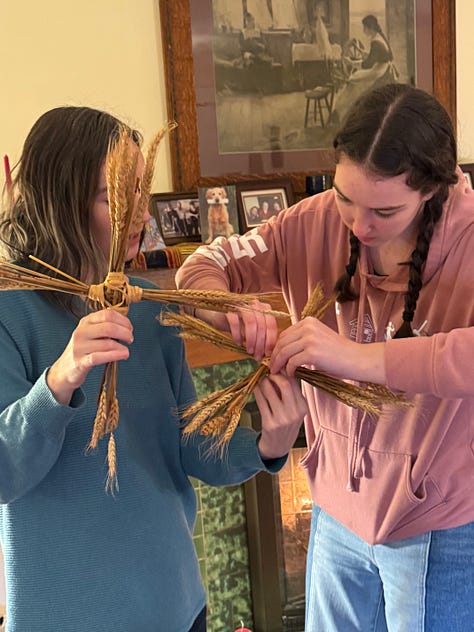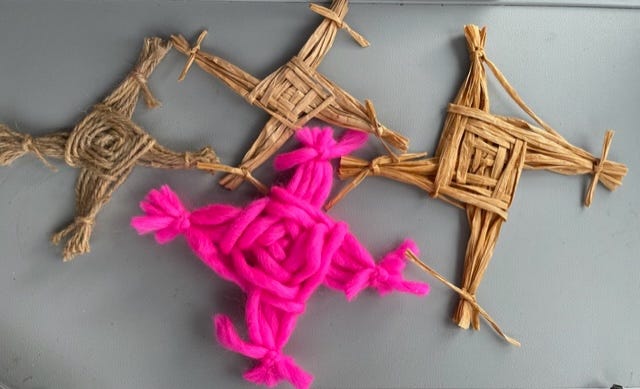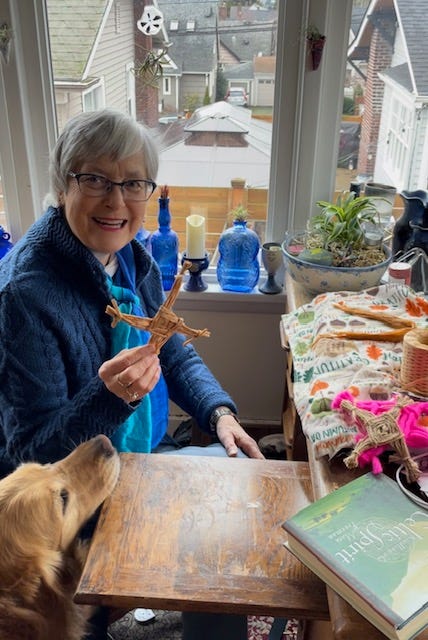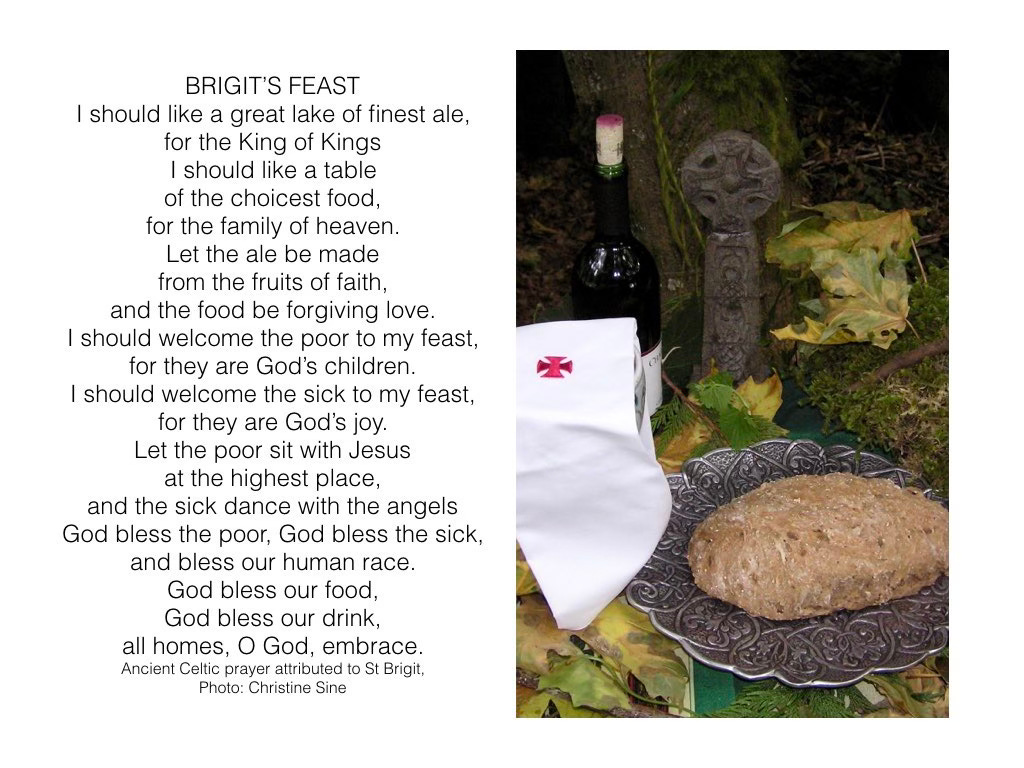The distinctive St. Brigid’s Cross design is thought to keep evil, fire and hunger from the homes in which it is displayed. It is traditionally made on the eve of St Brigid’s day, February 1st, and hung inside, over the door, so that St Brigid herself can come by and bless the cross and the houses in which she finds it. I love that in the delightful Irish film The Secret of Roan Inish, Fiona’s grandmother has a St Brigid’s cross on her wall.
Next week holds some very important and fun celebrations from many traditions and it is well worth exploring these and if possible celebrating at least one of them. As Kate Kennington Steer expressed in her Imbolc post a couple of years ago:
February 1st/2nd/3rd offers up multiple gifts to this season of grey: the Feast Day of St Brigid; Candlemas (the Feast of the Presentation of Jesus Christ, the Feast of the Purification of the Blessed Virgin Mary, and the Feast of the Holy Encounter); the Celtic festival of Imbolc; and lastly, the Saints day of Simeon and Anna. All four are intimately connected.
If you are unfamiliar with these traditions you might like to check out this video that Lilly Lewin and I put together as a Facebook live session a couple of years ago that talks about all three traditions.
Imbolc
For those who are unfamiliar with it, Imbolc is a well known pagan Celtic tradition stemming from Neolithic Ireland and Scotland. It celebrates the halfway point between Winter Solstice and Spring Equinox, considered by some to be the beginning of spring. However I must confess that here in Seattle, though spring might be in my mind it is certainly not yet in the air. This last week has been the coldest this winter and next week may not be much better.
It was this tradition that gave rise to Groundhog Day in the United States.
Candlemas
Candlemas, also known as the Feast of the Presentation of Jesus Christ, the Feast of the Purification of the Blessed Virgin Mary, or the Feast of the Holy Encounter, commemorates the presentation of Jesus at the Temple, based on the account in Luke 2:22–40. It also marks the conclusion of the Christmas–Epiphany season for some traditions. On Candlemas, many Christians (especially Eastern Orthodox, Roman Catholics, Lutherans, Anglicans and Methodists) also bring their candles to their local church, where they are blessed and then used for the rest of the year. These blessed candles serve as a symbol of Jesus Christ, the Light of the World. I know of some Christians who even bring their light bulbs in to be blessed because they don’t use candles.
Imbolc and Candlemas February 2nd are both celebrations of light and the first spark of spring. I love how Christianity took existing celebrations like this and transformed them into celebrations of faith. Imbolc and Candlemas are interwoven with the celebration of St Brigid’s day which begins on the evening of February 1st and extends to the evening of February 2nd. For Imbolc bonfires were often lit and combined with a feast to St Brigid.
St Brigid and a Distinctive Cross.
St Brigid is my favourite Celtic saint. She is also known as “Mary of the Gael”, was an abbess and is now patron saint of Ireland. She is founded the first Irish monastery in County Kildare, Ireland. Born in Dundalk in 450 AD, Brigid is accredited with first creating the unique cross which bears her name. This cross is normally hand created from rushes however occasionally straw was also used. Today, as these materials are rarely available people make crosses from yarn, pipe cleaners, strips of paper, or twine. I have seen some very creative crosses made by those who love to improvise.



This year I experimented with dried wheat stalks, which certainly produced the prettiest crosses I have created so far. We used this for our community meeting last week and everybody enjoyed the fun exercise. What we ended up with were rather untraditional crosses but certainly ones that we will all consider displaying on our walls for the coming year.
There is also a delightful tale about its creation.
An old pagan Chieftain lay delirious on his deathbed in Kildare (some believe this was Brigid’s father) and his servants summoned Brigid in the hope that the saintly woman could calm his restless spirit. Brigid is said to have sat by his bed, consoling and calming him . She picked up rushes from the floor and wove them into the distinctive cross pattern. Whilst she wove them, she explained the meaning of the cross to the sick Chieftain and it is thought her calming words brought peace to his soul. He was so enamoured by her words that the old Chieftain requested he be baptized as a Christian just before his passing. I can understand why this would have calmed him and made him receptive to the gospel. I find that creating St Brigid crosses is a very rhythmic, soothing and meditative practice.
Lets give it a go.
This description is adapted from Kindling the Celtic Spirit by Mara Freeman. A fun way to do this is to sit around a bonfire or fire pit while you create. Maybe even combine it with a feast of Celtic yummies. I don’t have any of the traditional Bride’s Bannock which is made either in a heavy iron skillet or a barbecue grill, I didn’t even have any Scottish shortbread left to celebrate with, but we still enjoyed the process in the spirit of St Brigid.
A couple of years ago I created a video of my St Brigid’s cross making process. You might like to watch this before you attempt to make your own.
What you will need:
28 or more strands of rushes, wheat stalks, yarn, twine, paper straws or straw about 10 - 15 inches each.
String for tying ends
I used Raffia Paper Craft Ribbon for this video but these year as I mentioned we used wheat stalks - really the most decorative we have made.
Additional crosses in the picture are made from Jute twine and knitting yarn. The fun thing about these is that you can make multicolored crosses if you like. The disadvantage is that the crosses are not as stiff when finished in fact the bright yarn cross is quite floppy. It didn’t last long either. You can probably tell from the video that my dog Goldie was quite fascinated by it and managed to get hold of it not long after this video was made and destroyed it.
As you can imagine this would be a very fun activity for kids.
Soak the weaving materials in hot water until they are flexible.The raffia and yarn only need to be dunked in water and then removed and wrung out. Wrap in a damp cloth to keep them flexible while weaving.
Imagine the face of a clock measuring the year of time. Place one straw vertically pointing toward 12 o’clock (north, winter) Fold.a second straw in half around the center of the first pointing towards 3 o’clock (east, spring) Fold the next straw in half and place it over the second straw pointing towards 6 o’clock (south, summer). Fold the next straw over straw 1 and 3, pointing towards 9 o’clock (west, autumn) Continue to work in a circular pattern of folded straws, progressing outwards, carefully weaving the straws side by side. Tighten the straws and reposition to fill in the gaps where needed.
As you create your cross, meditate on the events of your life, past, and present woven together. Visualize what you want to see happen in the coming year and consider that each straw weaves a dream for your future.
When at least 28 straws have been woven from the centre of the cross, tie off each arm, with about 3″ allowed for the arms. Trim ends evenly.
Once the cross is dry hang it inside by the door.
Finish by reciting Brigid’s Feast










Have a read of this article on the actual history of Ireland's Saint Brigid and how modern Ireland is seeking to alter its meaning.
https://open.substack.com/pub/jconole/p/re-inventing-brigid-the-new-irish?utm_source=share&utm_medium=android&r=4b73h